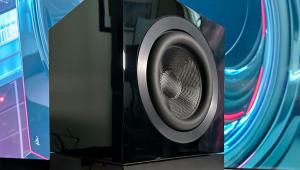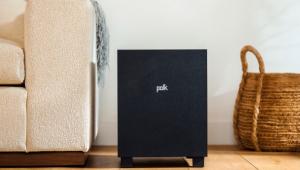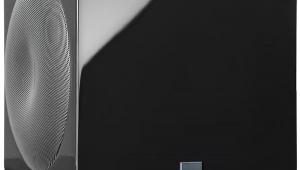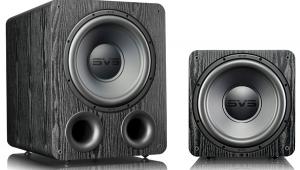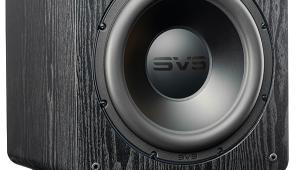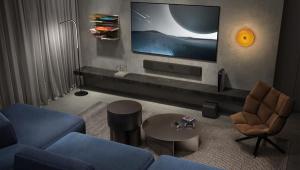KEF KC92 Subwoofer Review

AT A GLANCE
Plus
Tight, clean, deep bass
Small size
Flexible setup options
Five EQ settings
Minus
Pricey
No app
THE VERDICT
The KEF KC92 is ideal in a situation where space is a serious consideration but deep, impactful bass is a must. While it will be best suited to modestly-sized home theater spaces, it can also offer impressive performance in larger rooms, even at challenging output levels.
Most audiophiles today are familiar with the KEF brand. It's one of the most widely recognized names in loudspeakers, offering products ranging from the relatively affordable to the high-end. Established in the U.K. in 1961 by Raymond Cook, the company's name was derived from its original location, the Kent Engineering and Foundry. The Hong Kong-based Gold Peak Group acquired KEF in 1992. All of its products are currently designed and engineered in the U.K., but today most of them (including the KC92 subwoofer), are manufactured in China. One major exception to this are the KEF Blades, the company's highest-end loudspeakers that are still built in Kent.

KEF hasn't traditionally been known for subwoofers, but they now offer a range of them. While most are conventionally sized, at least two models are compact enough to blend seamlessly into a room in ways that most subwoofers can't.
Features
At 13.9 x 13 x 14.2 inches (H x W x D), the KEF KC92 isn't the smallest subwoofer in KEF's lineup, but it shares design principles with the more compact KC62 (priced at $1500). Both models use a pair of bass drivers positioned back-to-back on opposite sides of the cabinet in a "force-canceling" arrangement that minimizes cabinet vibrations. While the KC62 features 6.5-inch drivers, the newer KC92 is equipped with two 9-inch drivers. However, like most loudspeakers, the actual radiating diameter of the KC92's woofers is smaller—about 7 inches—with the remaining 2 inches consisting of the cones' flexible surrounds, which allow for significant fore-and-aft cone movement. The drivers' paper cones are reinforced with aluminum skins for added stiffness. Each of the KC92's internal woofers is powered by its own 500W class D amplifier, delivering a combined total of 1000 watts RMS. The cabinet is sealed for optimal performance.
KEF designed the KC92 assisted by a proprietary program it calls MIE (Music Integrity Engine). This program is said to evaluate and approve the design process, ensuring that everything works together as intended. Kudos to KEF for not referring to this feature by today's widely-used and abused high-tech acronym, AI, which it might easily have done.
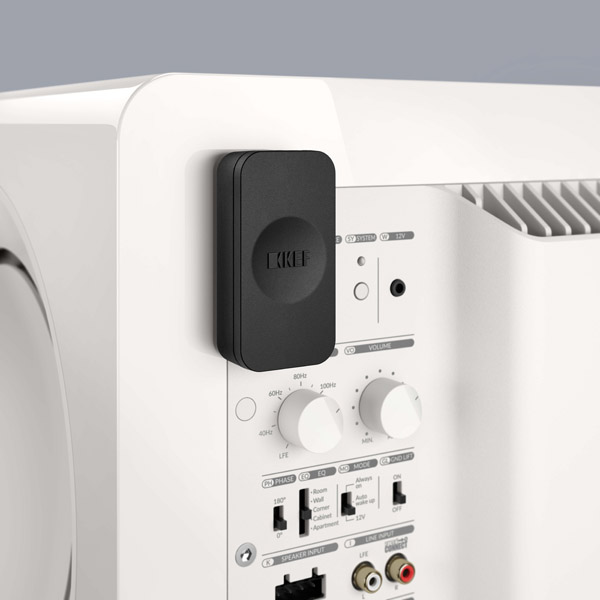
The KEFs setup features include a flood of adjustments. A volume control adjusts the subwoofer's output level and a frequency control sets the top end of the subwoofer's output to any frequency between 40 and 140 Hz. A (non-continuous) phase control offers two settings: zero or 180 degrees. An EQ control offers five preset options: Room, Wall, Corner, Cabinet, and Apartment, the latter dialing back on the loudest bass to keep it from annoying the neighbors. There's also a ground lift control to limit hum loops, and a control that sets the sub to be either on at all times or turned on only when a bass signal is detected.
Both high level and line level inputs are provided, plus a KW1 expansion port to accommodate an optional wireless connector (not provided or used here). Apart from the latter, the option you're most likely to choose for driving the KC92 in a home theater system will be the line-level subwoofer output from your AV receiver into the KEF's line level input(s). In a 2-channel system the KEF's high level inputs can be driven by the loudspeaker outputs from an integrated amp or separate power amp.
The User Manual included in KEF's shipping box uses a barely readable typeface for some text and diagrams. The version I downloaded from KEF's website was slightly more readable but differed somewhat from the printed manual. These inconsistencies likely stem from the need to accommodate the wide range of languages in KEF's global markets. The features mentioned in the previous two paragraphs were taken from the paper manual provided with the subwoofer in the U.S., not from the online manual.

The limited real estate on the black of the small KEF subwoofer offers little room for the small print located on or near the physical settings. This sometimes made it difficult to see and adjust those settings, particularly when crawling around on the floor. The best solution to this (not offered here) would have been to provide accessibility to the adjustments on a smart phone linked to the subwoofer via either a wired or wireless connection.
Challenges and Setup
Decades ago, Josef Hofmann, one of the original founders of speaker manufacturer KLH, proposed a principle known as Hofmann's Iron Law. It states that three key parameters in loudspeaker design—low bass reproduction, small enclosure size, and high output sensitivity—cannot all be achieved simultaneously without compromising at least one.
While Hofmann's law remains valid, it can be somewhat mitigated by using a high-powered amplifier to drive the loudspeaker, a technique widely employed today, especially for subwoofers. However, in Hofmann's era (the 1950s and 60s), such amplifiers were either rare or prohibitively expensive for commercial use.
Despite these limitations, KLH and the closely related company Acoustic Research pushed the technology as far as possible and enjoyed significant success for many years.
While there's still no absolute way around the Iron Law, the challenges are far less daunting than they were 75 years ago. Today, powered subwoofers can achieve an optimal balance of those three characteristics—small size, usable sensitivity, and deep bass. This balance is likely the primary function of yet another feature in KEF's toolbox: iBX (Intelligent Bass Extension).
Setting up a subwoofer is a complex task, too intricate to cover in detail here. Fortunately, online resources can provide extensive guidance. However, it's unlikely that a single subwoofer will deliver uniform bass at more than one or two listening positions without some extremely good luck. Using two or more subwoofers, placed in different positions in the room, significantly increases the chances of achieving balanced bass across multiple seats.

Finding the ideal locations for those subwoofers takes time, as they typically won't be near each other. Resist the temptation, often tried by audiophiles, to place the subwoofers near the left and right speakers and drive them separately with the left and right channels to achieve "stereo bass." This approach is generally ineffective in a 2-channel setup and a missed opportunity to optimize bass for multiple seats in a home theater setting.
But in this review we'll use only a single KEF KC92. As with any subwoofer, finding the best location for it can be a time consuming exercise. Yes, you can do it by ear, and after many trials (or good luck) achieve a respectable result. Using measurements to get there isn't mandatory but can speed up the process. I chose the latter to expedite this review, relying on my Parts Express Omnimic measurement system and its associated microphone. I connected the AVR's subwoofer output to one of the KEF subwoofer's line-level inputs, using a crossover of 80Hz.
The main front loudspeakers used here were Monitor Audio Silver floor standers (not the current generation) at the left and right, plus a Monitor Audio center. The surrounds and Atmos speakers were a mixed collection from other manufacturers (Revel Concerta bookshelves for surrounds and a quartet of PSB's tiny P3 Alphas for Atmos, the latter mounted near but not in the ceiling. The AV receiver was a Denon X6700H, and the disc player an Oppo UDP-203. The source materials were 2-channel CDs for music and Blu-rays for movies.
I left in place the Audyssey settings I've used before on this same speaker array (prior to including the KEF). I wasn't certain at first if those Audyssey settings would still be appropriate once the KEF subwoofer was added. I do know that using Audyssey in the mix reduces a 100-200 Hz peak in my room that's consistent (with minor variations) on most of the loudspeakers I've used there. Without Audyssey (or another similar room EQ process) the warmth added by the room could have been erroneously blamed on the KEF subwoofer. Fortunately the Audyssey fix worked out well here, though it might not be ideal in all systems and situations.
Performance: Music
The KEF KC92 subwoofer easily navigated a wide range of bass-heavy content from some of my most challenging CDs. These ranged from subtle to aggressive, some of them instrumental only, others were vocals supported by bass-heavy instrumentation including double bass, drums of every description, organ, and bass synthesizer.
The results were consistently impressive: tight, deep without bloat or overhang. Some selections here will be familiar to many readers. Bela Fleck's Flight of the Cosmic Hippo begins routinely before dropping down into the bass nether regions. Respighi's Pines of Rome is a combination of symphonic orchestra and pipe organ, and Toto's I Will Remember opens with a hard-hitting bass riff.
Other selections will be unfamiliar to many. These included several cuts of Japanese Kodo drummers, the group Riverdance's version of "Lift the Wings" (a song apparently inspired by the Irish migration to the New World), Michael Jonasz's rendition of Le Temps Passe, and Dadawa's Sister Drum: Home Without Shadows. The KEF, all handled these cuts, and many others flawlessly.
Movies
Tron: Legacy is a weird but compelling science fiction film about humans finding a way to enter cyberspace. Its multichannel soundtrack is exceptional, and KEF did not disappoint. There wasn't a ton of earth shattering bass (except near the finale), but since reviews of the Blu-ray suggest otherwise I'm inclined to blame this small shortcoming not on the KEF but on my very large room. It's a bit over 3000 cubic feet considering just the home theater's floor space, but more than double that when you add other spaces to which it's fully open and can't be sealed off.
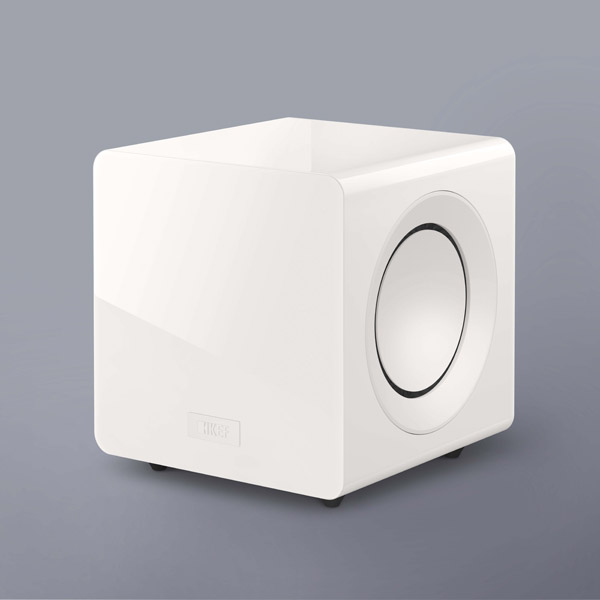
Given that caveat, I vaguely recall having heard more robust deep bass from this film when I last viewed it. But that was at least 10 years ago, in a much smaller room with a different, and larger, pair of subwoofers. But in the current viewing, with the single KEF and perhaps a more precise overall setup than in that hazy memory, I never found my enjoyment of the film limited or compromised in any way. In fact I viewed it from beginning to end rather than simply sampling a range of bass-heavy scenes.
Unbroken is a (mostly accurate) film about Italian-American Olympic runner Louis Zamperini. While his time in the 1936 Olympics is shown briefly, the film focuses on Zamperini's service in World War II. Most of it covers his grim experiences after his plane crashes in the Pacific ocean. The few survivors, including Zamperini, are captured and interred in POW camps for the remainder of the war.
But the first 30 minutes of the film depicts one of his pre-crash missions as a crewmember in a B-24 bomber. When the film was released in 2014 this opening sequence became prime demo fodder at home theater shows everywhere. It's alive with the roar of four noisy aircraft engines, wind from the open bomb bay doors as the crew attempts to close them, machine gun fire, exploding anti-aircraft flak, and a near tragic crash landing. While in some respects the KEF, in my room, didn't attempt to deliver the sort of ear-searing experience the above description might suggest. It was instead totally believable—realistic without pushing over-the-top simply for effect. Never having been in the same situation as the bomber crew, I can't say for certain exactly what real machine guns and flak explosions sound like. But I was impressed enough by the KEF's crisp, bottom-end clarity and startling punch to convince me that I'd rather not volunteer as a crew member on a B-24 bomber to experience the real thing!
Of all the films in my collection, however, Blade Runner 2049 offers possibly the most challenging bottom end. While the KEF can't quite match the sheer bass weight at high levels of the two ported, spatially displaced subwoofers that usually handle the deepest bass in my room, it came remarkably close at roughly one-eighth the total size. The KEF also surprised me in how it revealed to me (for the first time) some very deep and extremely low bass in both the abandoned factory scenes (as officer K/Joe searches for clues to his past) and, later, a sequence in a similarly abandoned Las Vegas.
Conclusion
The KEF KC92 offers superb engineering and performance. I hope I've made clear earlier the challenges involved in designing a very small subwoofer. To repeat, there's no free lunch. And if your room is unusually large you might want to consider (now or later) adding a second KC92s to the mix to fully complete the equation. But the designers of the KEF KC92 have come as close as anyone so far to solving the puzzle of achieving excellent bass from a small subwoofer. If your situation is compatible it might be just what you're looking for.
Test Bench

Left Channel Blue Right Channel Red
Single measurement at the listening seat smoothed to 1/6th octave using the Omnimic measurement system and microphone. Only the response below approximately 100 Hz is attributable to the KEF subwoofer. Below approximately 30Hz the results can be misleading, since the repeating Omnimic test sweep runs from extreme bottom end to the highest frequencies in about one second, which does not fully stress the subwoofer's response on the extreme bottom end. Nevertheless, the result is impressive.
Specifications
Design: Force Cancellation
Drive units: 2 x 9"
Frequency response (-3dB): 11 Hz - 200 Hz (-3dV)
Max output: 110dB
Amplifier type: Built-in Class D
Amplifier power: 2 x 500W WRMS
Variable Low-Pass Filter: 40Hz-140Hz
Input: Expansion port for KW1*
RCA phono sockets
Speaker level inputs
Power requirements: 100-240V 50/60Hz
Power consumption: 1000W (operating power)
Dimensions: 352.3 x 330 x 360.5 mm
H x W x D (mm with rear panel and feet): 13.9 x 13 x 14.2 inches
Weight: 20kg (44 lbs)
*Optional accessory: KW1 Wireless Adapter (not included here)


